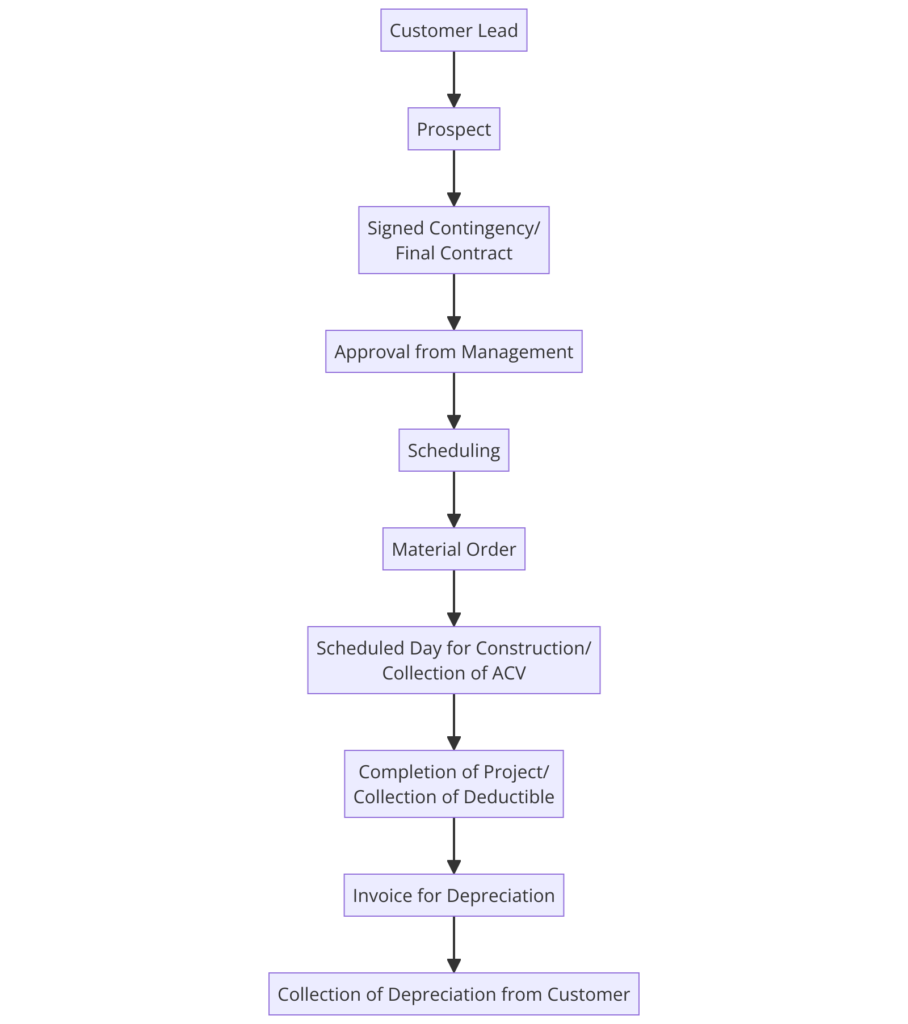The process and order of operations with insurance claims are generally fairly consistent. This overview will help you in establishing SOPs for your new roofing company.
To explain and visualize the workflow for a roofing company, especially for homeowners and those new to the roofing business, let’s break it down step-by-step, ending with a workflow diagram.
Thank you for reading this post, don’t forget to subscribe!A very Simple Explanation of the Workflow for a roofing company pursing insurance projects and benefitting from the the moderately increased profit margins possible; in contrast compare to cash deals where competition is real, in addition to a general race to the bottom concerning materials, labor, and general disregard considering the margins for these deals.
Customer Lead
This is the starting point where potential customers show interest in the roofing service, typically through a phone call, website inquiry, or referral.
Prospec
Once a lead shows more concrete interest, they become a prospect. Here, the company engages more deeply to understand the customer’s needs and potential roofing issues.
Signed Contingency Contract/Final Contract
If the prospect agrees to move forward, they sign a contingency contract which becomes binding once insurance approves the claim. A final contract may follow after negotiations and final terms are set.
Approval from Management
The signed contract and project details are reviewed and approved by company management to ensure everything is in order before work begins.
Scheduling
The project is scheduled based on the availability of resources, including labor and materials, and the customer’s preferred timing.
Material Order
Roofing materials required for the project are ordered from suppliers.
Scheduled Day for Construction/Collection of ACV
Construction begins on the scheduled day. ACV (Actual Cash Value) payments, which are the initial insurance payouts, are typically collected around this time.
Completion of Project/Collection of Deductible
Once the roofing project is completed, any deductible the homeowner is responsible for is collected.
Invoice for Depreciation
An invoice is sent to the customer for the depreciation amount claimed in the insurance, which covers the difference between the old roof’s value and the new roof’s cost.
Collection of Depreciation from Customer
Finally, the company collects the depreciation amount from the customer, completing the financial transactions related to the roofing project.
Workflow Diagram Creation:

- 10 Essential Steps To Starting Your Roofing Business
- Choosing the Best Accounting Software for Your New Roofing or construction Company.
- Cougar Paws: The Best Roofing Boots
- Deciding on a purpose made CRM roofing software for a new roofing or construction company.
- Does Radiant Barrier Installed On A Roof Work?
- Establishing an LLC for Your Roofing or Construction Company
- Finding Your Niche In the Vast Industry of Roofing
- Frequently Asked Questions (FAQs) for Starting a New Roofing Company
- How To Be Successful In The Roofing Business
- How To Measure A Roofing Square For Homeowners.
- Is Starting A Roofing Company Worth It?
- Most Common Roofing Terms
- Own a roofing company in two weeks. Turn a profit in 2 months.
- Privacy Policy
- Roofing SEO Services; Is It Actually Worth It?
- The Most Common Roofing Materials: Starting a Roofing Company
- The right ladder for a roofing salesman, insurance adjuster, or homeowner.
- The Tools needed for building a successful roofing company.
- What does damage, as defined by the insurance companies, look like, and how to identify it while assisting your roofing customer with the insurance claims process
